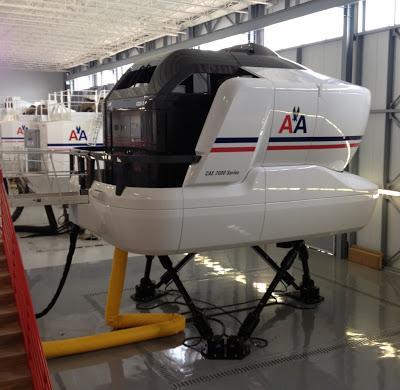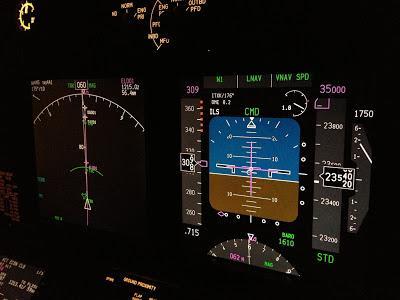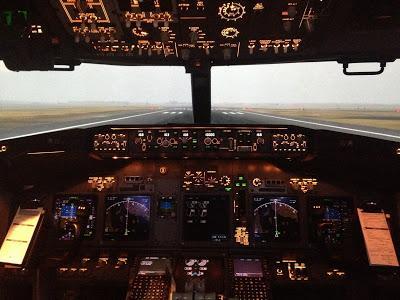
CAE 7000 Series Flight Simulator
As I drove home from the Flight Academy today, I felt like a 737 pilot for the first time. The first three weeks of training included self-paced computer based training and one-on-one review sessions with one of our ground school instructors as we learned everything we needed to know about the mechanics of the Boeing 737. We spent a small amount of time each day in the simulator learning normal procedures, flows and the proper way to conduct checklists, but motion was never turned on and our time in the sim was, for the most part, stress free. Before moving on to the simulator, we were tested over everything we had learned. Those tests were the source of a few restless nights for me, but I did well on the exams and was cleared to move on to the next phase. This week, we hit the simulator hard, but today I can honestly say I'm getting comfortable in the seat and feel like I belong on the airplane. I still have significant hoops to jump through, and it won't be official for two more weeks, but I feel like a 737 pilot.Before we stepped into the simulator on day one, someone told us the next five days would feel something like the old story about a frog being slowly boiled in a pot of water. The premise of that story being that a frog would attempt to escape if placed immediately in hot water, but if placed in cold water that was heated slowly, the frog would not perceive the danger and would be cooked to death. I wouldn't begin to describe the week that way. Admittedly, day one was a piece of cake. We performed normal takeoffs and landings, entered holding patterns, executed stalls, steep turns and unusual attitude recoveries and a few other maneuvers designed to get us comfortable with having the 737 control wheel in our hands. It was an enjoyable and relatively simple day. But instead of slowly turning up the heat, we were unceremoniously dropped into hot boiling water on day two and it really didn't let up until today.
Day two was especially difficult for me because we were performing maneuvers I had never flown with equipment I was still learning to understand and interpret. The Primary Flight Display (PFD) on the 737 is a significant step forward from the "six pack" instrument panel I've flown for the last 13 years. Everything is right there in front of me on one screen and every day I spend focused on it, I get a little more comfortable and see something I didn't see the day before. My instructor told me I would have a myopic view of the PFD at first and that I would, at first, feel as if I was looking through an empty paper towel roll. He was right about that, but my peripheral vision has gotten much better and I continue to see something new every day.

On top of my struggles to understand the PFD, day two was also difficult because it was time to learn how to fly LNAV/VNAV approaches. I was introduced to RNAV approaches years ago on the MD80 after the fleet was equipped with GFMS (GPS Flight Management System), but the simple act of adding VNAV to the equation threw me for a loop. To be clear, LNAV stands for Lateral Navigation and refers to navigating over a ground track with the help of an electronic device. I've been doing this for years on the 80. Conversely, VNAV stands for Vertical Navigation and refers to directing the aircraft in a vertical motion. If you put the two together on a single approach procedure, the airplane will arrive at the end of the runway at an altitude and position suitable for landing with no reference to ground based visual or electronic navigational aids. It's a little like flying into a funnel with the end pointed right at the end of the runway. I'm sure it sounds simple, but the vertical part of the equation if fraught with opportunities for small mistakes that could ruin an otherwise well flown approach.
Each day in the simulator, everything we learned the day before was now a given. We were expected to have mastered those skills and the next day's challenges would be experienced in conjunction with what was learned the day before. Day three came with the addition of single-engine scenarios. I knew I was in trouble when the instructor told me to set the airplane up for a takeoff from Salt Lake City, Utah. Salt Lake and Denver are favorites among instructors not only for learning how to fly the airplane on one engine, but doing so at high altitude airports with excessively warm temperatures. Both are factors that reduce the performance of the engines and wing and increase the workload for pilots. The temperature was set at 38 degrees Celsius...just over 100 Fahrenheit.

Day four was basically the same scenarios as before except that the passage of 24 hours brought heavy snow and ice to the mix. Each day my instructor tested us on something we had never done before. On one takeoff from Salk Lake City, he turned me into the mountains and refused my repeated requests for a turn. He wanted me to see the Ground Proximity Warning System (GPWS) in action. We got to within 20 seconds of impact before he let me react to the threat, but the 737 climbs well on two engines and even though we waited far longer than I would in real life, the airplane out-climbed the mountain face with ease. Later that same day, he set up a traffic conflict with two airplanes crossing my path. The TCAS (Traffic Collision Avoidance System) came to life and visually displayed a no fly zone above and below my aircraft as I threaded the needle between two jets, one 500 feet above and one 300 feet below my altitude. Each day was sprinkled with minor abnormal situations designed to get us into the checklists and paying attention to the jet. Start malfunctions, hydraulic leaks, faulty electrical generators, fires in the cabin, engines and cargo compartments...just to name a few.
Today, day five, was an easy day. We flew a LOFT (Line Oriented Flight Training) from Albuquerque, New Mexico to the Dallas Ft. Worth International Airport. We worked in real time and flew the trip as we would fly it for real. It was nice to see all the normal procedures we had learned spliced together in one flight. Before today, everything was segmented and almost nothing was done in real time. I was surprisingly relaxed and found myself constantly feeling like I should be doing something. I've become so accustomed to things failing, burning or falling off, that sitting there with a normal airplane felt completely abnormal.
After such a relaxing beginning to the period, we finished the day with a few final scenarios that were anything but relaxing. My sim partner and I each got a few more engine failures, one where the engine actually FELL OFF the wing and the second engine failed a short time later. With nowhere else to go, we were able to reverse course and land on a parallel runway with neither engine producing thrust. After that we reset the sim on short final to runway 17C at DFW and flew the infamous Delta 191 windshear event and finished the day with windshear on takeoff before we packed up our books and headed for the house.
I'm at home now and feeling good about the week. There have been a few times during the past month when I second guessed my decision to bid this jet, but as I become more and more comfortable in the seat, I am increasingly glad that I did. As I pulled away from the Flight Academy, I felt like a 737 pilot for the first time. I still have a week left of simulator training to go and will take two checkrides before they send me out to fly an Initial Operating Experience (IOE) trip under the watchful eye of one of our instructors. After that it will be my turn to be the new guy. It has been said that a Private Pilot's License is a license to learn. They don't, and really can't, teach you everything you need to know in school. My most valuable knowledge comes as a result of personal experience, not from what I read in books or was taught in a classroom. I've learned a lot over the past few weeks, but when I head out for my first trip two weeks from now, my new sign-off will be just that...a license to learn.
